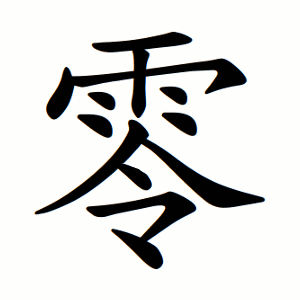零
- zero;
- to fall, to rain;
Etymology
Usage in Korean
Just as numbers like 1, 2, and 3 are written in Chinese as 一, 二, 三, the number 0 is written as 零 in Chinese. However, because 零 has many strokes, it is often simplified to the round symbol 〇 when writing numbers. In some cases—such as for preventing forgery—零 is used instead of 〇, and in such usage, it is considered a variant form (갖은자) of 〇. Thus, 零 is essentially a variant character for the number 0.
Another character, 空, also carries the meaning of "zero" or "empty" in Chinese, and since it has fewer strokes than 零, it is sometimes used in place of 零.
Words that derived from 零
Additional notes
The first known use of 零 to represent the concept of zero was by the Chinese mathematician Li Ye (李冶) in the year 1248.
Alternative forms
㩕 㬡 㯪 澪 燯 鿅 䌢 䙥 䴫 䴇 蕶
𠏡 𠟨 𨞖 𪞮 𨗺 𤖜 𤾨 𥋞 𥖟 𥢴 𥼸 𦪩 𨆖 𨣖 𨭭 𩁎 𩟃 𩪥 𪋪
𮋔 𮘿
零
떨어질
령
tteoreojil
yeong
Kangxi radical:173, 雨 + 5
Strokes:13
Unicode:U+96F6
Cangjie input:
- 一月人戈戈 (MBOII)
Composition:
- ⿱ ⻗ 令
